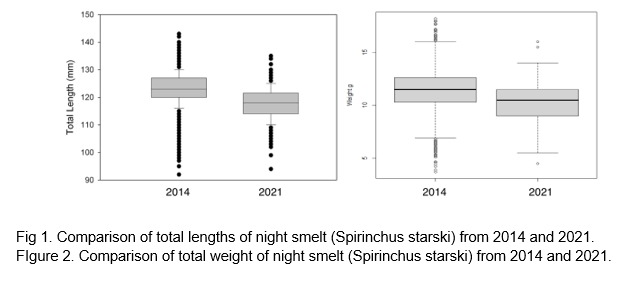CO-MANAGEMENT AND STATUS OF NIGHT SMELT Spirinchus starksi IN NORTHERN CALIFORNIA IN 2021
Night smelt ( Spirinchus starksi) occur from Central California to South East Alaska and spawn on the shore of sandy beach surf zones. This species is a vital part of regional food webs and
in California, is fished commercially, recreationally and for subsistence, primarily in
Humboldt and Del Norte counties. Night smelt are known as ch’uy-xee-ni in the Tolowaa Dee-ni’ Nations’ language. These fish are seen as an imperative part of the food resources for Indigenous tribal nations and have been documented as culturally significant to thirteen sovereign nations in the occupied north coast of California (Tolowa Dee-ni’ Nation, 2017). This species has been fished for subsistence and cultural purposes for time immemorial (Palmer et al. 2018). Despite the ecological, commercial and cultural importance of this species, very little is known about its biology and ecology. Consequently, there are currently no criteria to identify when this fishery is overfished or in decline. To study the status of these populations we collected adult night smelt with an A-frame net at six beaches in Humboldt and Del Norte counties once a month from March to September 2021. We then statistically compared length (mm, Total Length), weight (g) and sex ratio with data collected at the same beaches in 2014. We caught 529 fish on 9 of 35 days sampled in 2021. Length and weight averaged (±Standard Deviation) 11.7±0.8 cm TL and 10.4±1.9 g, and were significantly lower than 2014 values (12.2±6.0 cm TL, 11.5±2.5 g, respectively, p<0.01). Most of the fish were males (96%), which was slightly higher than during 2014 (93%, p<0.05). Our study suggests that at present Humboldt and Del Norte night smelt are smaller, lighter and more of them are males than almost a decade ago. These results suggest that these populations are in decline, potentially due to overfishing or unfavorable oceanographic conditions, and may require stricter regulations such as seasonal or annual closures.
